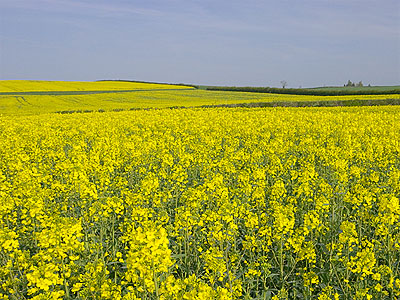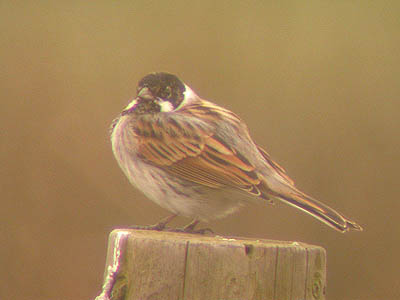

| Bird association with Oil-seed Rape | ||
 |
A typical modern aspect
of the UK countryside are the bright yellow fields of
Oil-seed Rape. Some 20 or 30 years ago, such fields were
rare enough to attract the public's attention when
driving through it, but Oil-seed is now one farming's
largest sources of income. The area here is no exception to anywhere else in the amount of land put-aside to it's production. Larger fields are rotated on an annual basis between cereals and Oil-seed Rape. What has never been clearly ascertained previously, is whether these fields provide any benefits to our farmland birds and insects. The answer was quick in coming when I started covering the area in 1998 and was an over-whelming yes. I have not physically sat and completely researched what would be a very useful study, the purpose of this article being to raise people's awareness of Oil-seed Rape as an attraction and aid to many breeding species through my own casual observations. |
|
| .... | ||
| These fields
are certainly not devoid of birds as many might think and
since 1998 I have regularly recorded scarce species such
as Quail in 1998, 2001, 2002 and Grasshopper Warbler
(most years) among an array of commoner species.
Throughout any year, Oil-seed Rape fields are in constant
use by many of our native species. This comes despite a
regular spraying routine of the crop with fungicides and
pesticides. General herbicides are used prior to sowing
and some time after harvesting. Certain influential aspects, such as time of year/stage of crop growth etc, helps determine which species use the fields most. To simplify this - throughout the Winter months, when crop growth is short, species like Wood Pigeon, Lapwing, Fieldfare, Redwing, Meadow Pipit and some finches and buntings are the prime users. This changes during the course of plant growth in Spring and Summer - through to harvesting later in the year. Only if the ground becomes totally frozen during the Winter months, do birds desert it's use as a potential source of food. With crop growth the following Spring, Wood Pigeon and certainly Lapwing, rarely venture into the crop as a result of inability (through size) to gain enough access to feed. Large numbers of Wood Pigeon occur here during the Winter months and numbers can reach up to 5000 birds. Such large numbers can cause severe devastation within a crop and much of any single field can be lost. Wood Pigeons cannot be blamed entirely for the loss of any part of a crop here. Much can be attributable to wet weather during the Autumn and Winter months. As the soil here is clay-based, fields are often almost totally saturated and the young crop basically rots away in the absence of drier weather. |
||
| Winter | Spring | Summer | Autumn | |||||
| Crop-growth | Young crop-growth, often with large open areas where plants have died through water-logged soil | Quick crop-growth and flowering by late May. Crop attains height and open areas become few. Several species use flower heads as song posts | Full height attained by crop. Seed ripens as plants begin to die off | Dead crop harvested for seed. Remaining stubble allows plant growth of common annual weeds and remnants of previous year's cereal crop | ||||
| Feeding | Allows ground-feeding by Wood Pigeon, Lapwing, Game birds, Winter thrushes and many smaller passerines | Limited ground-feeding capabilities due to crop growth. Most common users now Blackbird, Song Thrush, and small passerines | No ground feeding access for Wood Pigeon or Lapwing. Small passerines dominate (including Whitethroat and Sedge Warbler where nesting nearby) Attracts Blackbird and Song Thrush in good numbers | Harvesting allows access to all species, but very few warblers. Wood Pigeon and Lapwing return. Finches and buntings dominate. | ||||
| Insect availability | Predominantly soil-living invertebrates, near surface during milder weather and in wetter conditions | Increased numbers of both airborne and soil-living invertebrates as temperature rises. Many insect larvae now available | Peak numbers of invertebrates available, masses of caterpillars, spiders etc | Still large numbers of invertebrates and spilt seed. Crop harvesting means many insects and spiders are now exposed and vulnerable to bird predation | ||||
| .... | ||
| One important benefit birds gain in Winter through the modern-day production of Oil-seed Rape, is that these fields are not so prone to becoming totally frozen, as are the more open-growing cereal crops. The typical fleshy Brassicae leaves initially keep much of the worst of any frost or snow off the soil. In a prolonged period of cold weather, this seems to provide a short window of opportunity for feeding and both Meadow Pipits and Skylarks can often it seems here, find enough food to sustain them through the entire cold spell without having to resort to moving out of the area. Maybe this is one reason why large Skylark movements during cold weather are now so rare? Only if there are large falls of snow, do the birds have to move. This could be supported by the fact that only during heavy snow in late December 2000, has there been such a movement through the Eakring area. | ||
| .... | ||
| During the Spring and
Summer months, the large leaves and copious growth
Oil-seed Rape puts on during the course of the season,
prevents virtually all direct sunshine from reaching the
soil surface. This means soil moisture is retained more
readily than in other crops. This also allows soil invertebrates to remain nearer the surface and it is this factor which probably induces Blackbirds and Song Thrushes to fly greater distances to Oil-seed Rape fields when feeding young. This has been noticed when fields are just outsde the village. Birds nesting or holding territories within Eakring, make constant trips throughout any day when young are being fed. These birds fly over other suitable feeding sites (mostly damp pastureland) on their way to feed. Foraging must therefore be much easier and another factor is perhaps safety from predators like Sparrowhawks. Smaller passerines like warblers, finches and buntings also use the fields for feeding, but don't seem to travel a distance to reach it. |
 |
|
| .... | ||
| In 1999, I
deliberately looked for increased numbers of certain
breeding species around a field of Oil-seed Rape that was
growing immediately adjacent to Eakring Flash. One of the
species I selected for this was the Reed Bunting - a
species which regularly uses the flower-heads as a song
post (even in the centre of what was a very large field)
There was no really discernable increase in breeding
pairs that year (or in similar years since) that could be
positively attributed to birds deliberately nesting near
such an excellent food source. Although there has been a
slight increase in breeding pairs since 1998, this is
perhaps more safely put down to a greater availablity of
suitable nesting habitat at the site (as surrounding
vegetation matured) rather than Reed Buntings having
opportunistic nesting habitats. In late Summer (shortly after being sprayed for the final time) the crop is harvested, soon withering and dying. Once harvested, the stubble field allows virtually any species to forage on the abundance of invertebrates and spilt seed available. The variety of birds at this time, is probably now greater than at any other time of year as Lapwing, Wood Pigeon and many others, are able to return to feed. Weed growth and remnants of the previous year's cereal crop starts once more, after being shaded out in the Spring by the much quicker and substantial growth of the Oil-seed Rape crop. It's a time when all birds benefit from such a food supply. Post-breeding finches and sparrows are attracted in numbers and groups of Collared Doves frequently hold small numbers of Turtle Dove. During September, post-breeding finch numbers are augmented by further arrivals of migrants and large numbers of Linnets can especially build up. Greenfinch numbers also regularly reach in excess of 100 birds here and Oil-seed Rape fields are quite often preferred for feeding, ahead of traditonal cereal stubble. In summary, perhaps the availability of Oil-seed Rape is playing an increasingly important part of any bird's survival in modern-day farmland than we have previously supposed? Oil-seed Rape fields potentially hold a vast array of invertebrates, attracting larger numbers of birds than many people may thought. A reduction in the use of herbicidal sprays through more environmentally friendly farming practices, could see these fields provide an even more important role as a food-source. If field margins were less vigorously maintained, their attraction could increase even further. |
||